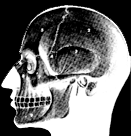21st Century Graffiti: Detroit Tagging: Essay by Jeff Rice. Intro: >Compuware Headquarters, located at 1 Campus Martius near the base of Woodward Avenue in downtown Detroit, marks the site of the new, urban landscape. Compuware, a leading Information Technology corporation, manufactures management, software applications and offers IT services to a number of global businesses. Where Detroit once signified the success and perils of Modernism, specifically those moments denoted by Fordist assembly line methodology, today Detroit emerges as the signifier of techno-salvation. The lure of Compuware to Detroit, solidified in its 2003 opening, begins the final replacement of industrialization with information technology. The sixteen story, $350 million building is now the focal point of what the city itself calls "Digital Detroit," a title embodied in an annual conference of the same name. Wayne State University contributes to this technology-driven enthusiasm with plans for its own downtown technology site, TechTown, a "new multi-million dollar entrepreneurial village" "located along the Digital Drive in the heart of the city of Detroit." Detroiter Iggy Pop's declaration "Look out, honey, cause I'm using technology," in the 1973 song "Search and Destroy," is no longer a threat, but instead a desired reality as Detroit embraces the turn to the digital. This desire is realized in Digital Detroit, which dubs itself "New Ideas, New Culture, New Community." The label updates the Fordist plan of "Americanization" in the early half of the 20th century with a digitized sense of urban identity. Fordism triumphed homogenous identity for the sake of manufacturing; Digital Detroit triumphs "newness" in order to generate new media. The empty factories which initially gave birth to Ford and Chrysler supremacy throughout the first half of the 20th century have yielded to the McLuhanist vision of information dominance. "In the new electric Age of Information and programmed production," Marshall McLuhan wrote in the 1960s, "commodities themselves assume more and more the character of information." How has Detroit come to represent the new signifier of urban information? How has its commodification placed urbanity at the center of new media logic? The commodification of our cities (through franchises, capital, gentrification) has not yielded "better" places to live. No matter how many Hard Rock Cafés or Borders we attract to downtown environments, life remains the same. Buildings remain unoccupied. Ruins surround the franchises. This paradox, the Detroit Free Press notes, continues even as the city claims a high profile for attracting IT and other commercial investment.<
Link
posted by johannes,
Wednesday, June 08, 2005
[The Archives]

.
.
.
.
.
|
.
.
.
|